Analysis of Leadership, Management, and Conflict at M&S Report
VerifiedAdded on 2020/06/04
|12
|4356
|31
Report
AI Summary
This report provides an in-depth analysis of leadership and management practices within Marks & Spencer (M&S). It explores the relationship between leadership and management, highlighting various leadership styles such as autocratic, democratic, and free reign, and their impact on employee motivation and organizational success. The report also delves into the nature of conflict in the workplace, differentiating between intra-personal, interpersonal, and intergroup conflicts, along with their potential causes, such as organizational structure and employee benefit disparities. The report examines the corporate culture of M&S, including its inflexibility and resistance to change, and how these factors influence employee behavior and the need for leadership to adapt strategies for effective management. Overall, the report emphasizes the importance of effective leadership and management in achieving organizational goals, fostering employee engagement, and navigating workplace conflicts to enhance productivity and profitability.
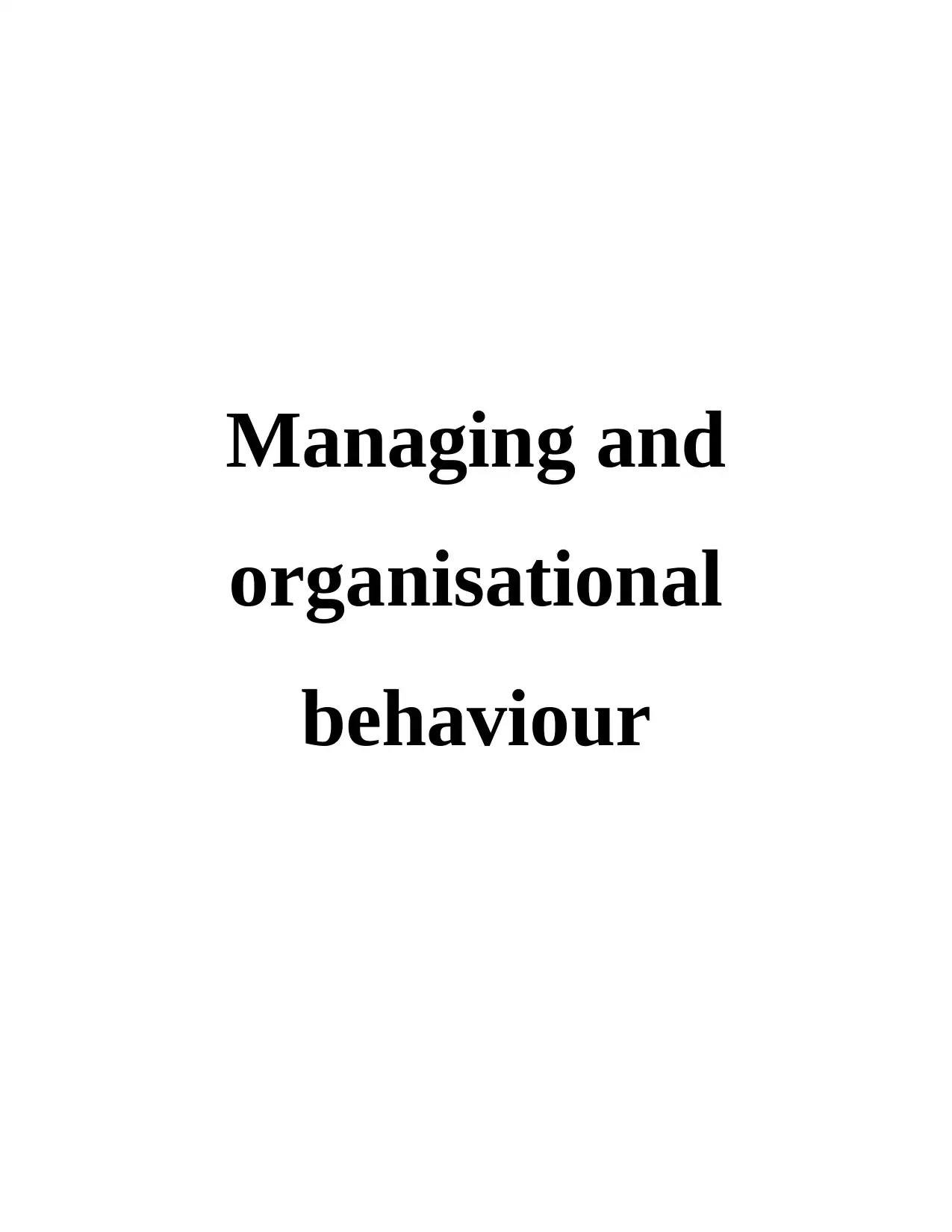
Managing and
organisational
behaviour
organisational
behaviour
Paraphrase This Document
Need a fresh take? Get an instant paraphrase of this document with our AI Paraphraser
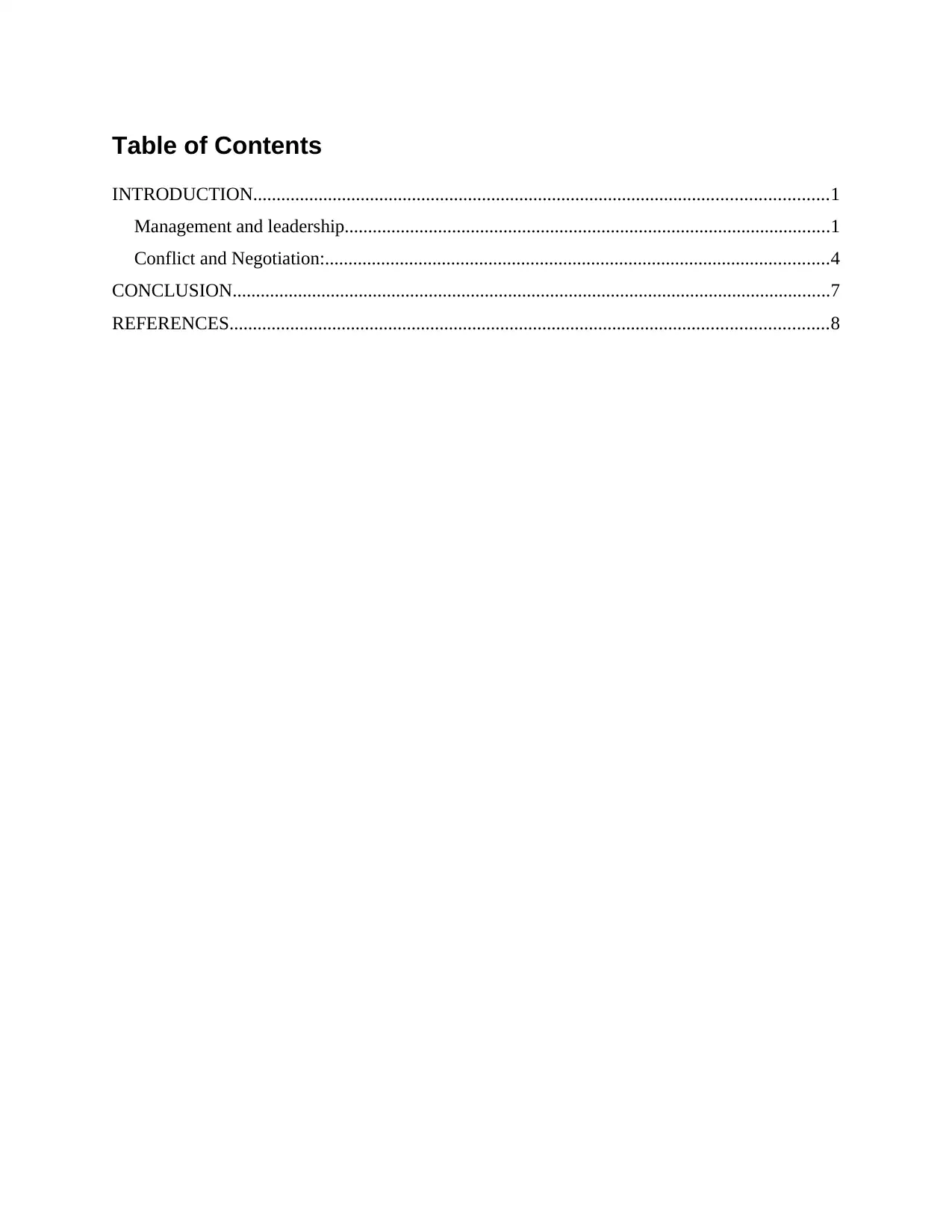
Table of Contents
INTRODUCTION...........................................................................................................................1
Management and leadership........................................................................................................1
Conflict and Negotiation:............................................................................................................4
CONCLUSION................................................................................................................................7
REFERENCES................................................................................................................................8
INTRODUCTION...........................................................................................................................1
Management and leadership........................................................................................................1
Conflict and Negotiation:............................................................................................................4
CONCLUSION................................................................................................................................7
REFERENCES................................................................................................................................8
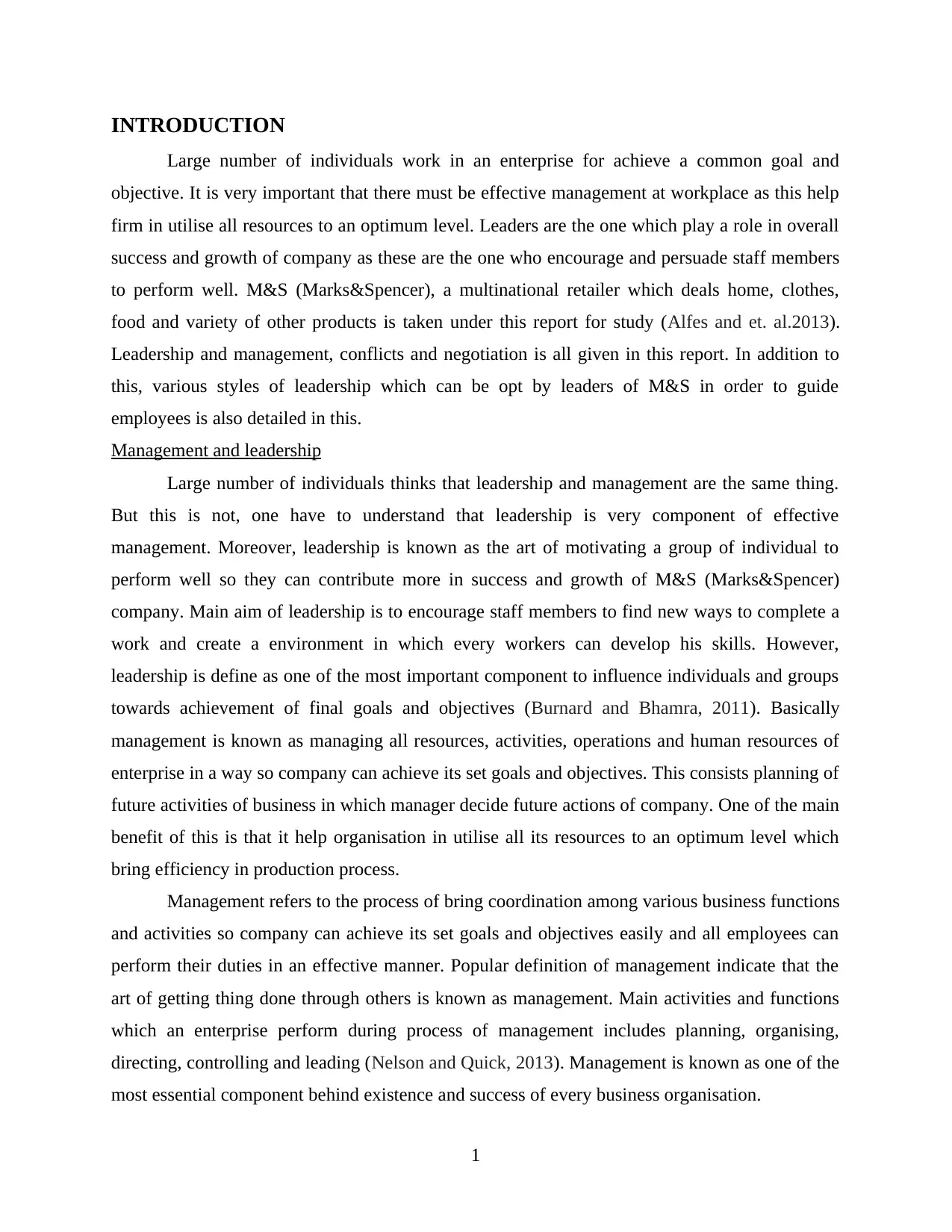
INTRODUCTION
Large number of individuals work in an enterprise for achieve a common goal and
objective. It is very important that there must be effective management at workplace as this help
firm in utilise all resources to an optimum level. Leaders are the one which play a role in overall
success and growth of company as these are the one who encourage and persuade staff members
to perform well. M&S (Marks&Spencer), a multinational retailer which deals home, clothes,
food and variety of other products is taken under this report for study (Alfes and et. al.2013).
Leadership and management, conflicts and negotiation is all given in this report. In addition to
this, various styles of leadership which can be opt by leaders of M&S in order to guide
employees is also detailed in this.
Management and leadership
Large number of individuals thinks that leadership and management are the same thing.
But this is not, one have to understand that leadership is very component of effective
management. Moreover, leadership is known as the art of motivating a group of individual to
perform well so they can contribute more in success and growth of M&S (Marks&Spencer)
company. Main aim of leadership is to encourage staff members to find new ways to complete a
work and create a environment in which every workers can develop his skills. However,
leadership is define as one of the most important component to influence individuals and groups
towards achievement of final goals and objectives (Burnard and Bhamra, 2011). Basically
management is known as managing all resources, activities, operations and human resources of
enterprise in a way so company can achieve its set goals and objectives. This consists planning of
future activities of business in which manager decide future actions of company. One of the main
benefit of this is that it help organisation in utilise all its resources to an optimum level which
bring efficiency in production process.
Management refers to the process of bring coordination among various business functions
and activities so company can achieve its set goals and objectives easily and all employees can
perform their duties in an effective manner. Popular definition of management indicate that the
art of getting thing done through others is known as management. Main activities and functions
which an enterprise perform during process of management includes planning, organising,
directing, controlling and leading (Nelson and Quick, 2013). Management is known as one of the
most essential component behind existence and success of every business organisation.
1
Large number of individuals work in an enterprise for achieve a common goal and
objective. It is very important that there must be effective management at workplace as this help
firm in utilise all resources to an optimum level. Leaders are the one which play a role in overall
success and growth of company as these are the one who encourage and persuade staff members
to perform well. M&S (Marks&Spencer), a multinational retailer which deals home, clothes,
food and variety of other products is taken under this report for study (Alfes and et. al.2013).
Leadership and management, conflicts and negotiation is all given in this report. In addition to
this, various styles of leadership which can be opt by leaders of M&S in order to guide
employees is also detailed in this.
Management and leadership
Large number of individuals thinks that leadership and management are the same thing.
But this is not, one have to understand that leadership is very component of effective
management. Moreover, leadership is known as the art of motivating a group of individual to
perform well so they can contribute more in success and growth of M&S (Marks&Spencer)
company. Main aim of leadership is to encourage staff members to find new ways to complete a
work and create a environment in which every workers can develop his skills. However,
leadership is define as one of the most important component to influence individuals and groups
towards achievement of final goals and objectives (Burnard and Bhamra, 2011). Basically
management is known as managing all resources, activities, operations and human resources of
enterprise in a way so company can achieve its set goals and objectives. This consists planning of
future activities of business in which manager decide future actions of company. One of the main
benefit of this is that it help organisation in utilise all its resources to an optimum level which
bring efficiency in production process.
Management refers to the process of bring coordination among various business functions
and activities so company can achieve its set goals and objectives easily and all employees can
perform their duties in an effective manner. Popular definition of management indicate that the
art of getting thing done through others is known as management. Main activities and functions
which an enterprise perform during process of management includes planning, organising,
directing, controlling and leading (Nelson and Quick, 2013). Management is known as one of the
most essential component behind existence and success of every business organisation.
1
⊘ This is a preview!⊘
Do you want full access?
Subscribe today to unlock all pages.

Trusted by 1+ million students worldwide
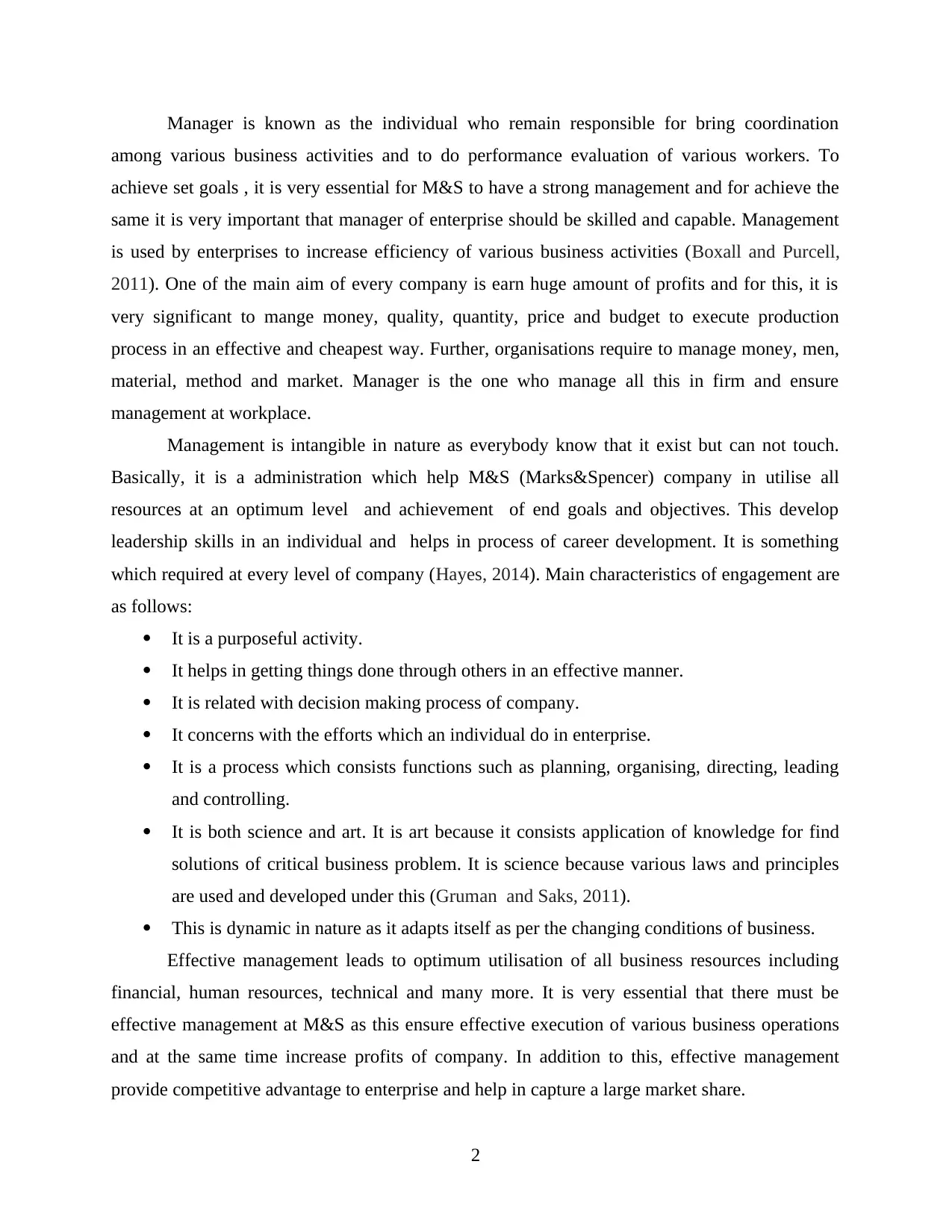
Manager is known as the individual who remain responsible for bring coordination
among various business activities and to do performance evaluation of various workers. To
achieve set goals , it is very essential for M&S to have a strong management and for achieve the
same it is very important that manager of enterprise should be skilled and capable. Management
is used by enterprises to increase efficiency of various business activities (Boxall and Purcell,
2011). One of the main aim of every company is earn huge amount of profits and for this, it is
very significant to mange money, quality, quantity, price and budget to execute production
process in an effective and cheapest way. Further, organisations require to manage money, men,
material, method and market. Manager is the one who manage all this in firm and ensure
management at workplace.
Management is intangible in nature as everybody know that it exist but can not touch.
Basically, it is a administration which help M&S (Marks&Spencer) company in utilise all
resources at an optimum level and achievement of end goals and objectives. This develop
leadership skills in an individual and helps in process of career development. It is something
which required at every level of company (Hayes, 2014). Main characteristics of engagement are
as follows:
It is a purposeful activity.
It helps in getting things done through others in an effective manner.
It is related with decision making process of company.
It concerns with the efforts which an individual do in enterprise.
It is a process which consists functions such as planning, organising, directing, leading
and controlling.
It is both science and art. It is art because it consists application of knowledge for find
solutions of critical business problem. It is science because various laws and principles
are used and developed under this (Gruman and Saks, 2011).
This is dynamic in nature as it adapts itself as per the changing conditions of business.
Effective management leads to optimum utilisation of all business resources including
financial, human resources, technical and many more. It is very essential that there must be
effective management at M&S as this ensure effective execution of various business operations
and at the same time increase profits of company. In addition to this, effective management
provide competitive advantage to enterprise and help in capture a large market share.
2
among various business activities and to do performance evaluation of various workers. To
achieve set goals , it is very essential for M&S to have a strong management and for achieve the
same it is very important that manager of enterprise should be skilled and capable. Management
is used by enterprises to increase efficiency of various business activities (Boxall and Purcell,
2011). One of the main aim of every company is earn huge amount of profits and for this, it is
very significant to mange money, quality, quantity, price and budget to execute production
process in an effective and cheapest way. Further, organisations require to manage money, men,
material, method and market. Manager is the one who manage all this in firm and ensure
management at workplace.
Management is intangible in nature as everybody know that it exist but can not touch.
Basically, it is a administration which help M&S (Marks&Spencer) company in utilise all
resources at an optimum level and achievement of end goals and objectives. This develop
leadership skills in an individual and helps in process of career development. It is something
which required at every level of company (Hayes, 2014). Main characteristics of engagement are
as follows:
It is a purposeful activity.
It helps in getting things done through others in an effective manner.
It is related with decision making process of company.
It concerns with the efforts which an individual do in enterprise.
It is a process which consists functions such as planning, organising, directing, leading
and controlling.
It is both science and art. It is art because it consists application of knowledge for find
solutions of critical business problem. It is science because various laws and principles
are used and developed under this (Gruman and Saks, 2011).
This is dynamic in nature as it adapts itself as per the changing conditions of business.
Effective management leads to optimum utilisation of all business resources including
financial, human resources, technical and many more. It is very essential that there must be
effective management at M&S as this ensure effective execution of various business operations
and at the same time increase profits of company. In addition to this, effective management
provide competitive advantage to enterprise and help in capture a large market share.
2
Paraphrase This Document
Need a fresh take? Get an instant paraphrase of this document with our AI Paraphraser
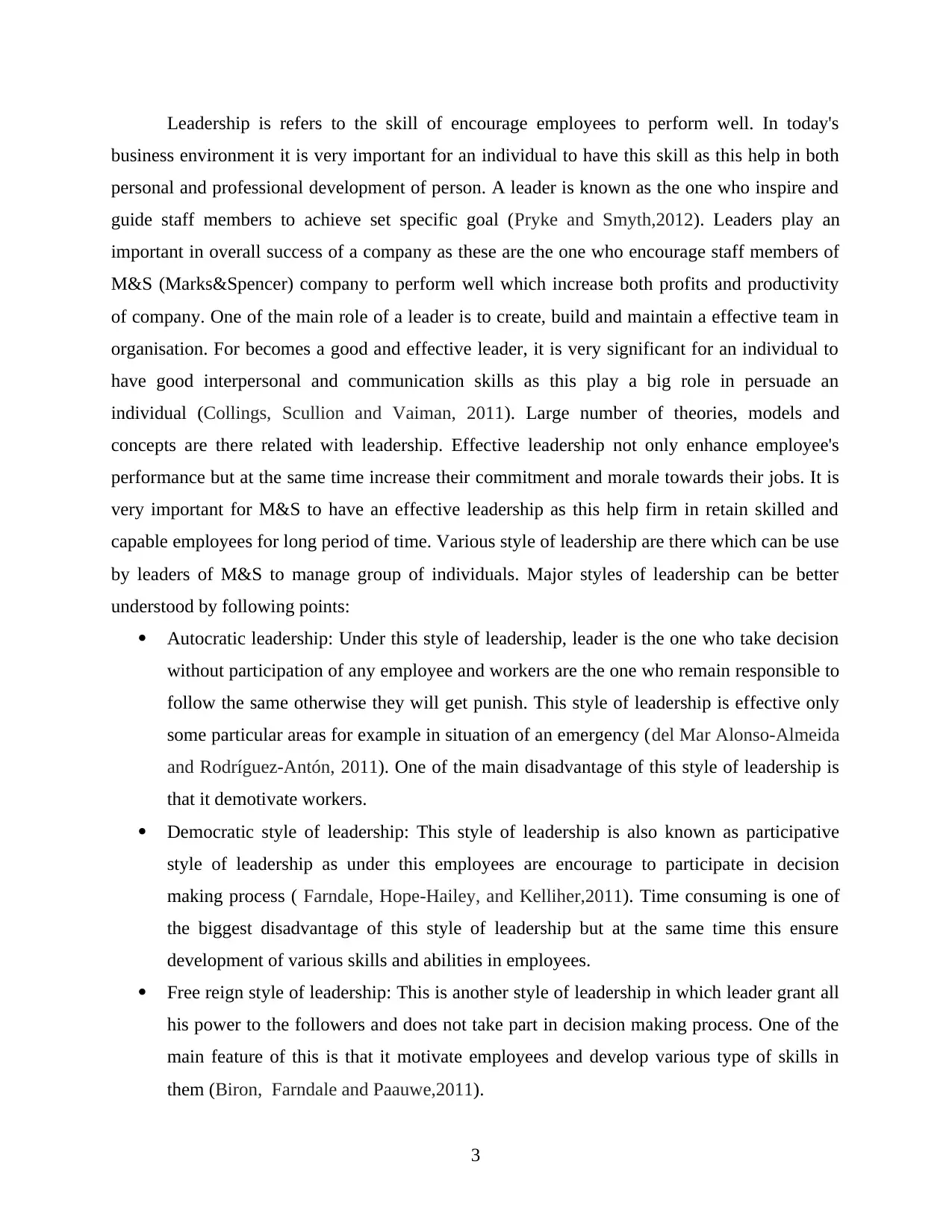
Leadership is refers to the skill of encourage employees to perform well. In today's
business environment it is very important for an individual to have this skill as this help in both
personal and professional development of person. A leader is known as the one who inspire and
guide staff members to achieve set specific goal (Pryke and Smyth,2012). Leaders play an
important in overall success of a company as these are the one who encourage staff members of
M&S (Marks&Spencer) company to perform well which increase both profits and productivity
of company. One of the main role of a leader is to create, build and maintain a effective team in
organisation. For becomes a good and effective leader, it is very significant for an individual to
have good interpersonal and communication skills as this play a big role in persuade an
individual (Collings, Scullion and Vaiman, 2011). Large number of theories, models and
concepts are there related with leadership. Effective leadership not only enhance employee's
performance but at the same time increase their commitment and morale towards their jobs. It is
very important for M&S to have an effective leadership as this help firm in retain skilled and
capable employees for long period of time. Various style of leadership are there which can be use
by leaders of M&S to manage group of individuals. Major styles of leadership can be better
understood by following points:
Autocratic leadership: Under this style of leadership, leader is the one who take decision
without participation of any employee and workers are the one who remain responsible to
follow the same otherwise they will get punish. This style of leadership is effective only
some particular areas for example in situation of an emergency (del Mar Alonso-Almeida
and Rodríguez-Antón, 2011). One of the main disadvantage of this style of leadership is
that it demotivate workers.
Democratic style of leadership: This style of leadership is also known as participative
style of leadership as under this employees are encourage to participate in decision
making process ( Farndale, Hope-Hailey, and Kelliher,2011). Time consuming is one of
the biggest disadvantage of this style of leadership but at the same time this ensure
development of various skills and abilities in employees.
Free reign style of leadership: This is another style of leadership in which leader grant all
his power to the followers and does not take part in decision making process. One of the
main feature of this is that it motivate employees and develop various type of skills in
them (Biron, Farndale and Paauwe,2011).
3
business environment it is very important for an individual to have this skill as this help in both
personal and professional development of person. A leader is known as the one who inspire and
guide staff members to achieve set specific goal (Pryke and Smyth,2012). Leaders play an
important in overall success of a company as these are the one who encourage staff members of
M&S (Marks&Spencer) company to perform well which increase both profits and productivity
of company. One of the main role of a leader is to create, build and maintain a effective team in
organisation. For becomes a good and effective leader, it is very significant for an individual to
have good interpersonal and communication skills as this play a big role in persuade an
individual (Collings, Scullion and Vaiman, 2011). Large number of theories, models and
concepts are there related with leadership. Effective leadership not only enhance employee's
performance but at the same time increase their commitment and morale towards their jobs. It is
very important for M&S to have an effective leadership as this help firm in retain skilled and
capable employees for long period of time. Various style of leadership are there which can be use
by leaders of M&S to manage group of individuals. Major styles of leadership can be better
understood by following points:
Autocratic leadership: Under this style of leadership, leader is the one who take decision
without participation of any employee and workers are the one who remain responsible to
follow the same otherwise they will get punish. This style of leadership is effective only
some particular areas for example in situation of an emergency (del Mar Alonso-Almeida
and Rodríguez-Antón, 2011). One of the main disadvantage of this style of leadership is
that it demotivate workers.
Democratic style of leadership: This style of leadership is also known as participative
style of leadership as under this employees are encourage to participate in decision
making process ( Farndale, Hope-Hailey, and Kelliher,2011). Time consuming is one of
the biggest disadvantage of this style of leadership but at the same time this ensure
development of various skills and abilities in employees.
Free reign style of leadership: This is another style of leadership in which leader grant all
his power to the followers and does not take part in decision making process. One of the
main feature of this is that it motivate employees and develop various type of skills in
them (Biron, Farndale and Paauwe,2011).
3
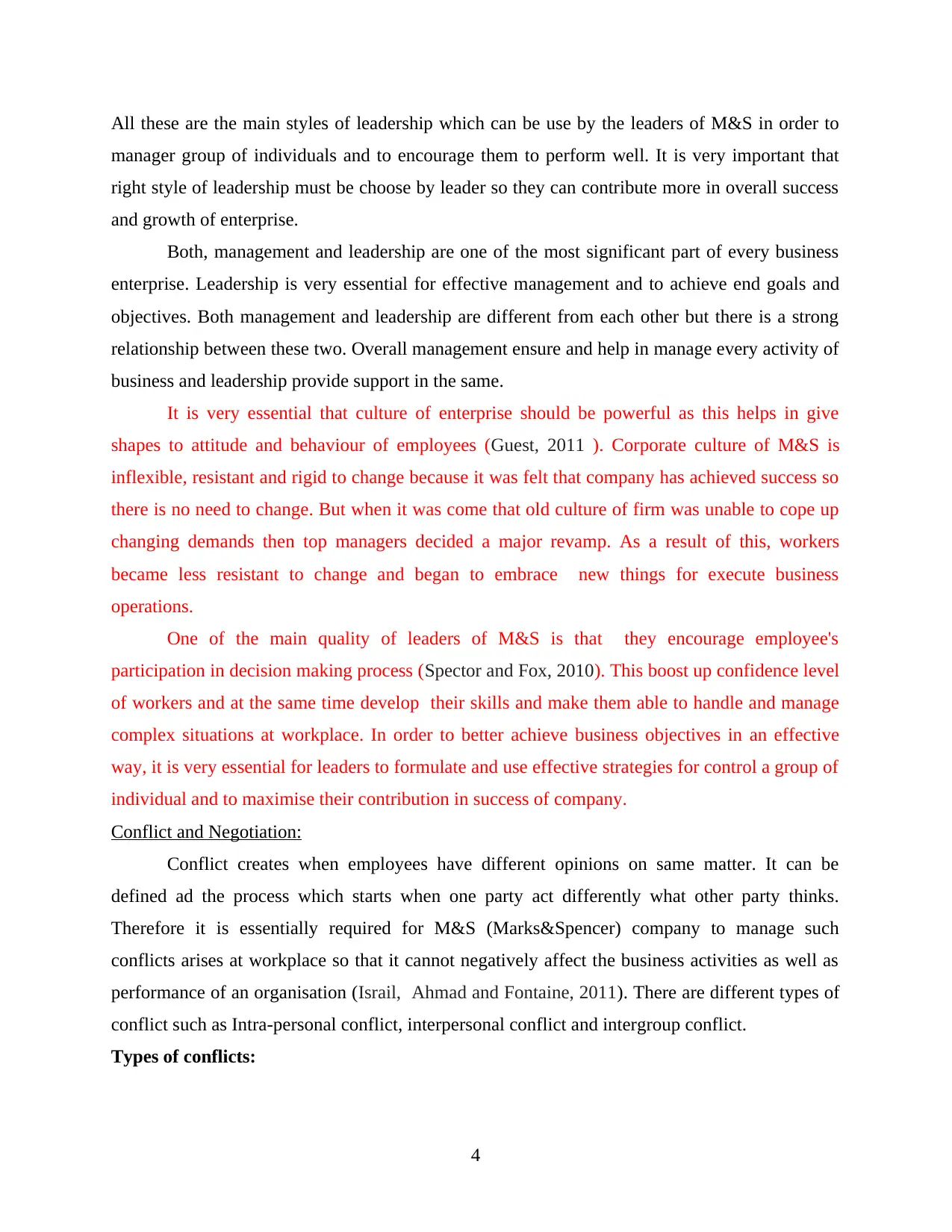
All these are the main styles of leadership which can be use by the leaders of M&S in order to
manager group of individuals and to encourage them to perform well. It is very important that
right style of leadership must be choose by leader so they can contribute more in overall success
and growth of enterprise.
Both, management and leadership are one of the most significant part of every business
enterprise. Leadership is very essential for effective management and to achieve end goals and
objectives. Both management and leadership are different from each other but there is a strong
relationship between these two. Overall management ensure and help in manage every activity of
business and leadership provide support in the same.
It is very essential that culture of enterprise should be powerful as this helps in give
shapes to attitude and behaviour of employees (Guest, 2011 ). Corporate culture of M&S is
inflexible, resistant and rigid to change because it was felt that company has achieved success so
there is no need to change. But when it was come that old culture of firm was unable to cope up
changing demands then top managers decided a major revamp. As a result of this, workers
became less resistant to change and began to embrace new things for execute business
operations.
One of the main quality of leaders of M&S is that they encourage employee's
participation in decision making process (Spector and Fox, 2010). This boost up confidence level
of workers and at the same time develop their skills and make them able to handle and manage
complex situations at workplace. In order to better achieve business objectives in an effective
way, it is very essential for leaders to formulate and use effective strategies for control a group of
individual and to maximise their contribution in success of company.
Conflict and Negotiation:
Conflict creates when employees have different opinions on same matter. It can be
defined ad the process which starts when one party act differently what other party thinks.
Therefore it is essentially required for M&S (Marks&Spencer) company to manage such
conflicts arises at workplace so that it cannot negatively affect the business activities as well as
performance of an organisation (Israil, Ahmad and Fontaine, 2011). There are different types of
conflict such as Intra-personal conflict, interpersonal conflict and intergroup conflict.
Types of conflicts:
4
manager group of individuals and to encourage them to perform well. It is very important that
right style of leadership must be choose by leader so they can contribute more in overall success
and growth of enterprise.
Both, management and leadership are one of the most significant part of every business
enterprise. Leadership is very essential for effective management and to achieve end goals and
objectives. Both management and leadership are different from each other but there is a strong
relationship between these two. Overall management ensure and help in manage every activity of
business and leadership provide support in the same.
It is very essential that culture of enterprise should be powerful as this helps in give
shapes to attitude and behaviour of employees (Guest, 2011 ). Corporate culture of M&S is
inflexible, resistant and rigid to change because it was felt that company has achieved success so
there is no need to change. But when it was come that old culture of firm was unable to cope up
changing demands then top managers decided a major revamp. As a result of this, workers
became less resistant to change and began to embrace new things for execute business
operations.
One of the main quality of leaders of M&S is that they encourage employee's
participation in decision making process (Spector and Fox, 2010). This boost up confidence level
of workers and at the same time develop their skills and make them able to handle and manage
complex situations at workplace. In order to better achieve business objectives in an effective
way, it is very essential for leaders to formulate and use effective strategies for control a group of
individual and to maximise their contribution in success of company.
Conflict and Negotiation:
Conflict creates when employees have different opinions on same matter. It can be
defined ad the process which starts when one party act differently what other party thinks.
Therefore it is essentially required for M&S (Marks&Spencer) company to manage such
conflicts arises at workplace so that it cannot negatively affect the business activities as well as
performance of an organisation (Israil, Ahmad and Fontaine, 2011). There are different types of
conflict such as Intra-personal conflict, interpersonal conflict and intergroup conflict.
Types of conflicts:
4
⊘ This is a preview!⊘
Do you want full access?
Subscribe today to unlock all pages.

Trusted by 1+ million students worldwide
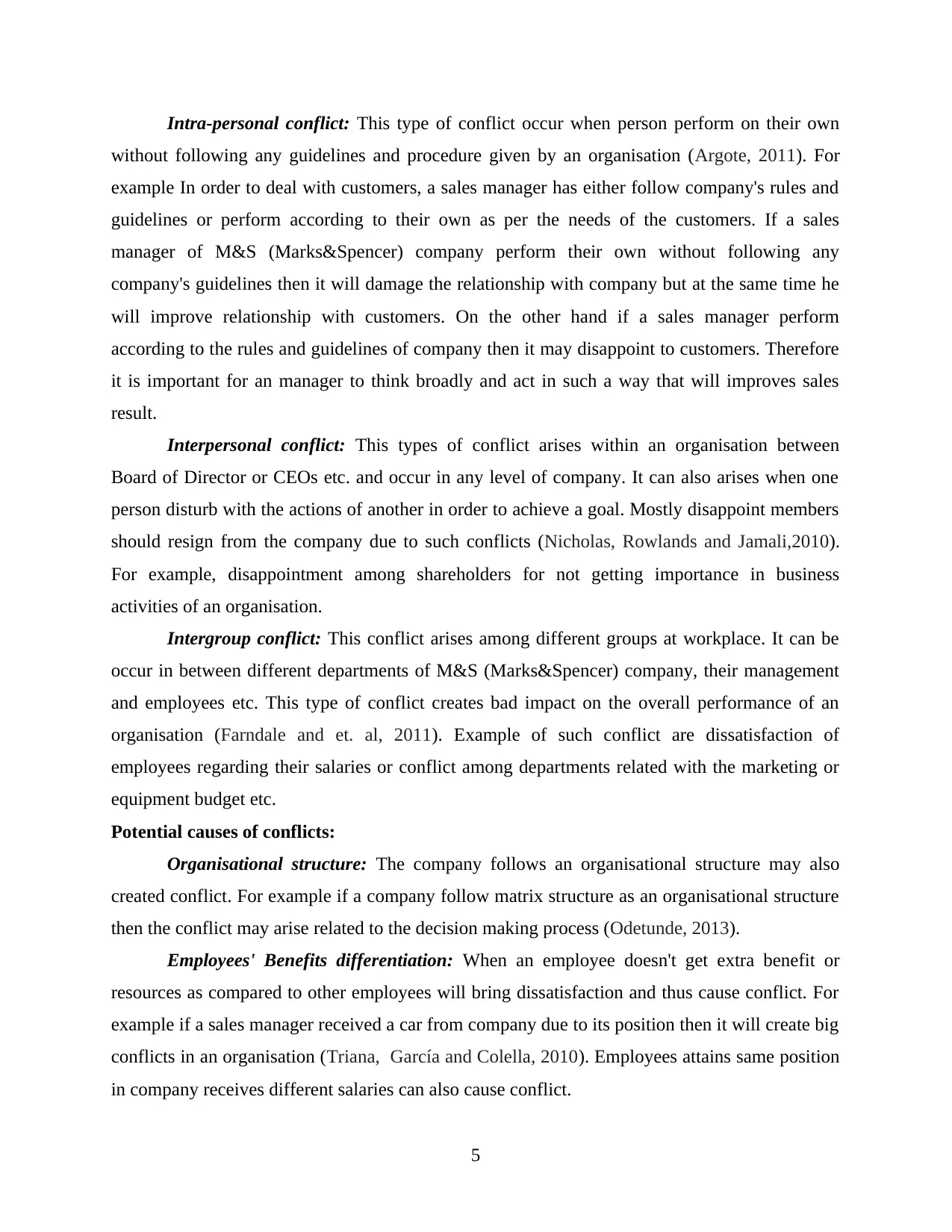
Intra-personal conflict: This type of conflict occur when person perform on their own
without following any guidelines and procedure given by an organisation (Argote, 2011). For
example In order to deal with customers, a sales manager has either follow company's rules and
guidelines or perform according to their own as per the needs of the customers. If a sales
manager of M&S (Marks&Spencer) company perform their own without following any
company's guidelines then it will damage the relationship with company but at the same time he
will improve relationship with customers. On the other hand if a sales manager perform
according to the rules and guidelines of company then it may disappoint to customers. Therefore
it is important for an manager to think broadly and act in such a way that will improves sales
result.
Interpersonal conflict: This types of conflict arises within an organisation between
Board of Director or CEOs etc. and occur in any level of company. It can also arises when one
person disturb with the actions of another in order to achieve a goal. Mostly disappoint members
should resign from the company due to such conflicts (Nicholas, Rowlands and Jamali,2010).
For example, disappointment among shareholders for not getting importance in business
activities of an organisation.
Intergroup conflict: This conflict arises among different groups at workplace. It can be
occur in between different departments of M&S (Marks&Spencer) company, their management
and employees etc. This type of conflict creates bad impact on the overall performance of an
organisation (Farndale and et. al, 2011). Example of such conflict are dissatisfaction of
employees regarding their salaries or conflict among departments related with the marketing or
equipment budget etc.
Potential causes of conflicts:
Organisational structure: The company follows an organisational structure may also
created conflict. For example if a company follow matrix structure as an organisational structure
then the conflict may arise related to the decision making process (Odetunde, 2013).
Employees' Benefits differentiation: When an employee doesn't get extra benefit or
resources as compared to other employees will bring dissatisfaction and thus cause conflict. For
example if a sales manager received a car from company due to its position then it will create big
conflicts in an organisation (Triana, García and Colella, 2010). Employees attains same position
in company receives different salaries can also cause conflict.
5
without following any guidelines and procedure given by an organisation (Argote, 2011). For
example In order to deal with customers, a sales manager has either follow company's rules and
guidelines or perform according to their own as per the needs of the customers. If a sales
manager of M&S (Marks&Spencer) company perform their own without following any
company's guidelines then it will damage the relationship with company but at the same time he
will improve relationship with customers. On the other hand if a sales manager perform
according to the rules and guidelines of company then it may disappoint to customers. Therefore
it is important for an manager to think broadly and act in such a way that will improves sales
result.
Interpersonal conflict: This types of conflict arises within an organisation between
Board of Director or CEOs etc. and occur in any level of company. It can also arises when one
person disturb with the actions of another in order to achieve a goal. Mostly disappoint members
should resign from the company due to such conflicts (Nicholas, Rowlands and Jamali,2010).
For example, disappointment among shareholders for not getting importance in business
activities of an organisation.
Intergroup conflict: This conflict arises among different groups at workplace. It can be
occur in between different departments of M&S (Marks&Spencer) company, their management
and employees etc. This type of conflict creates bad impact on the overall performance of an
organisation (Farndale and et. al, 2011). Example of such conflict are dissatisfaction of
employees regarding their salaries or conflict among departments related with the marketing or
equipment budget etc.
Potential causes of conflicts:
Organisational structure: The company follows an organisational structure may also
created conflict. For example if a company follow matrix structure as an organisational structure
then the conflict may arise related to the decision making process (Odetunde, 2013).
Employees' Benefits differentiation: When an employee doesn't get extra benefit or
resources as compared to other employees will bring dissatisfaction and thus cause conflict. For
example if a sales manager received a car from company due to its position then it will create big
conflicts in an organisation (Triana, García and Colella, 2010). Employees attains same position
in company receives different salaries can also cause conflict.
5
Paraphrase This Document
Need a fresh take? Get an instant paraphrase of this document with our AI Paraphraser
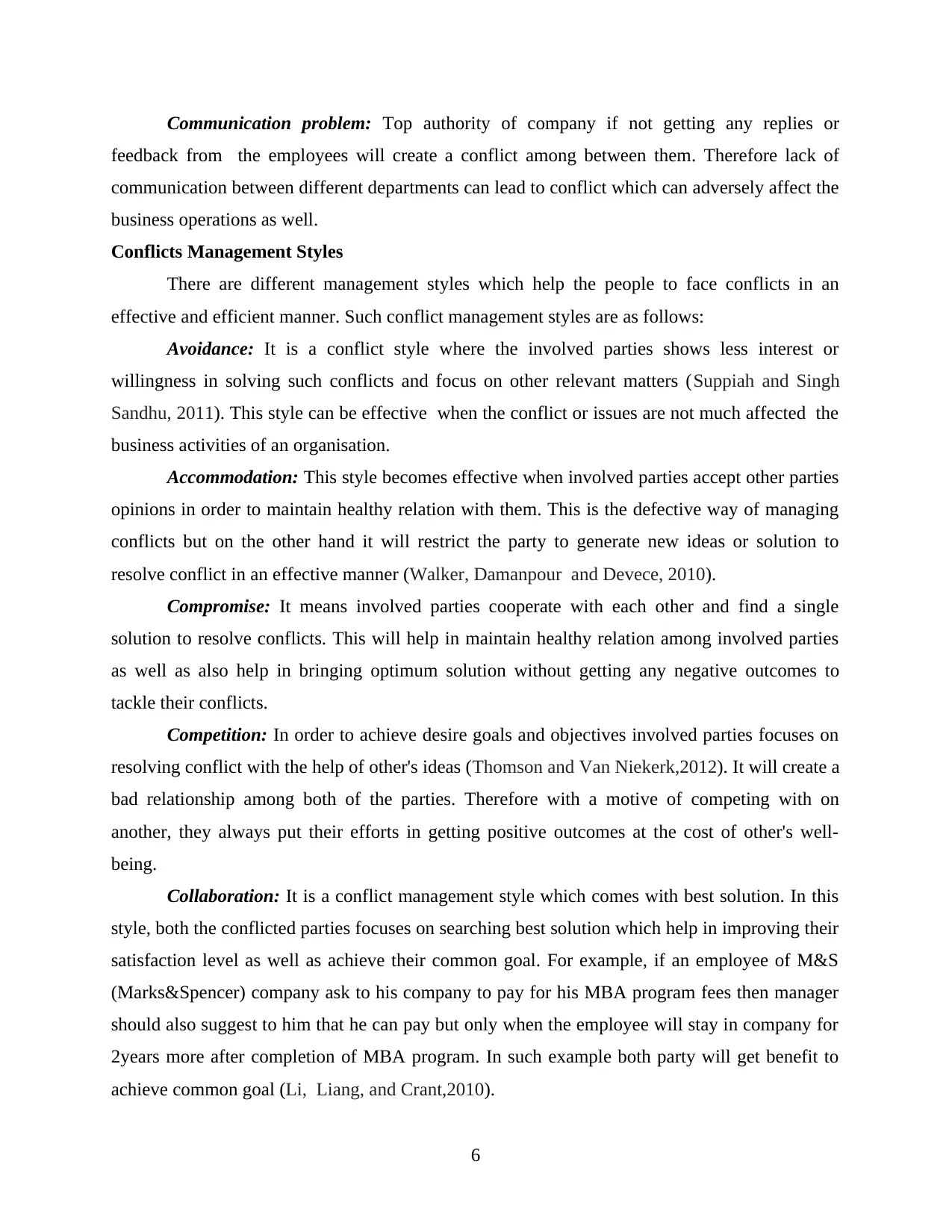
Communication problem: Top authority of company if not getting any replies or
feedback from the employees will create a conflict among between them. Therefore lack of
communication between different departments can lead to conflict which can adversely affect the
business operations as well.
Conflicts Management Styles
There are different management styles which help the people to face conflicts in an
effective and efficient manner. Such conflict management styles are as follows:
Avoidance: It is a conflict style where the involved parties shows less interest or
willingness in solving such conflicts and focus on other relevant matters (Suppiah and Singh
Sandhu, 2011). This style can be effective when the conflict or issues are not much affected the
business activities of an organisation.
Accommodation: This style becomes effective when involved parties accept other parties
opinions in order to maintain healthy relation with them. This is the defective way of managing
conflicts but on the other hand it will restrict the party to generate new ideas or solution to
resolve conflict in an effective manner (Walker, Damanpour and Devece, 2010).
Compromise: It means involved parties cooperate with each other and find a single
solution to resolve conflicts. This will help in maintain healthy relation among involved parties
as well as also help in bringing optimum solution without getting any negative outcomes to
tackle their conflicts.
Competition: In order to achieve desire goals and objectives involved parties focuses on
resolving conflict with the help of other's ideas (Thomson and Van Niekerk,2012). It will create a
bad relationship among both of the parties. Therefore with a motive of competing with on
another, they always put their efforts in getting positive outcomes at the cost of other's well-
being.
Collaboration: It is a conflict management style which comes with best solution. In this
style, both the conflicted parties focuses on searching best solution which help in improving their
satisfaction level as well as achieve their common goal. For example, if an employee of M&S
(Marks&Spencer) company ask to his company to pay for his MBA program fees then manager
should also suggest to him that he can pay but only when the employee will stay in company for
2years more after completion of MBA program. In such example both party will get benefit to
achieve common goal (Li, Liang, and Crant,2010).
6
feedback from the employees will create a conflict among between them. Therefore lack of
communication between different departments can lead to conflict which can adversely affect the
business operations as well.
Conflicts Management Styles
There are different management styles which help the people to face conflicts in an
effective and efficient manner. Such conflict management styles are as follows:
Avoidance: It is a conflict style where the involved parties shows less interest or
willingness in solving such conflicts and focus on other relevant matters (Suppiah and Singh
Sandhu, 2011). This style can be effective when the conflict or issues are not much affected the
business activities of an organisation.
Accommodation: This style becomes effective when involved parties accept other parties
opinions in order to maintain healthy relation with them. This is the defective way of managing
conflicts but on the other hand it will restrict the party to generate new ideas or solution to
resolve conflict in an effective manner (Walker, Damanpour and Devece, 2010).
Compromise: It means involved parties cooperate with each other and find a single
solution to resolve conflicts. This will help in maintain healthy relation among involved parties
as well as also help in bringing optimum solution without getting any negative outcomes to
tackle their conflicts.
Competition: In order to achieve desire goals and objectives involved parties focuses on
resolving conflict with the help of other's ideas (Thomson and Van Niekerk,2012). It will create a
bad relationship among both of the parties. Therefore with a motive of competing with on
another, they always put their efforts in getting positive outcomes at the cost of other's well-
being.
Collaboration: It is a conflict management style which comes with best solution. In this
style, both the conflicted parties focuses on searching best solution which help in improving their
satisfaction level as well as achieve their common goal. For example, if an employee of M&S
(Marks&Spencer) company ask to his company to pay for his MBA program fees then manager
should also suggest to him that he can pay but only when the employee will stay in company for
2years more after completion of MBA program. In such example both party will get benefit to
achieve common goal (Li, Liang, and Crant,2010).
6
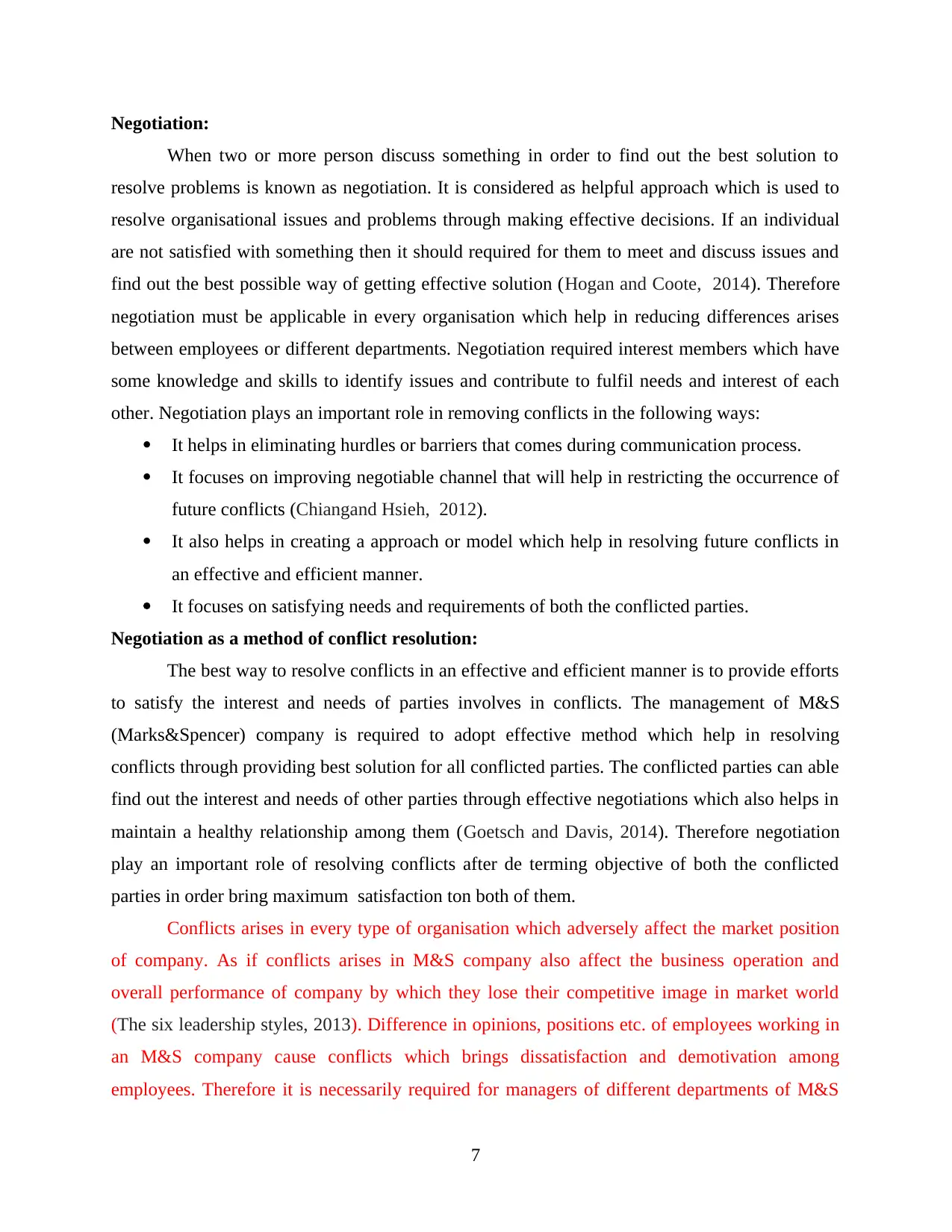
Negotiation:
When two or more person discuss something in order to find out the best solution to
resolve problems is known as negotiation. It is considered as helpful approach which is used to
resolve organisational issues and problems through making effective decisions. If an individual
are not satisfied with something then it should required for them to meet and discuss issues and
find out the best possible way of getting effective solution (Hogan and Coote, 2014). Therefore
negotiation must be applicable in every organisation which help in reducing differences arises
between employees or different departments. Negotiation required interest members which have
some knowledge and skills to identify issues and contribute to fulfil needs and interest of each
other. Negotiation plays an important role in removing conflicts in the following ways:
It helps in eliminating hurdles or barriers that comes during communication process.
It focuses on improving negotiable channel that will help in restricting the occurrence of
future conflicts (Chiangand Hsieh, 2012).
It also helps in creating a approach or model which help in resolving future conflicts in
an effective and efficient manner.
It focuses on satisfying needs and requirements of both the conflicted parties.
Negotiation as a method of conflict resolution:
The best way to resolve conflicts in an effective and efficient manner is to provide efforts
to satisfy the interest and needs of parties involves in conflicts. The management of M&S
(Marks&Spencer) company is required to adopt effective method which help in resolving
conflicts through providing best solution for all conflicted parties. The conflicted parties can able
find out the interest and needs of other parties through effective negotiations which also helps in
maintain a healthy relationship among them (Goetsch and Davis, 2014). Therefore negotiation
play an important role of resolving conflicts after de terming objective of both the conflicted
parties in order bring maximum satisfaction ton both of them.
Conflicts arises in every type of organisation which adversely affect the market position
of company. As if conflicts arises in M&S company also affect the business operation and
overall performance of company by which they lose their competitive image in market world
(The six leadership styles, 2013). Difference in opinions, positions etc. of employees working in
an M&S company cause conflicts which brings dissatisfaction and demotivation among
employees. Therefore it is necessarily required for managers of different departments of M&S
7
When two or more person discuss something in order to find out the best solution to
resolve problems is known as negotiation. It is considered as helpful approach which is used to
resolve organisational issues and problems through making effective decisions. If an individual
are not satisfied with something then it should required for them to meet and discuss issues and
find out the best possible way of getting effective solution (Hogan and Coote, 2014). Therefore
negotiation must be applicable in every organisation which help in reducing differences arises
between employees or different departments. Negotiation required interest members which have
some knowledge and skills to identify issues and contribute to fulfil needs and interest of each
other. Negotiation plays an important role in removing conflicts in the following ways:
It helps in eliminating hurdles or barriers that comes during communication process.
It focuses on improving negotiable channel that will help in restricting the occurrence of
future conflicts (Chiangand Hsieh, 2012).
It also helps in creating a approach or model which help in resolving future conflicts in
an effective and efficient manner.
It focuses on satisfying needs and requirements of both the conflicted parties.
Negotiation as a method of conflict resolution:
The best way to resolve conflicts in an effective and efficient manner is to provide efforts
to satisfy the interest and needs of parties involves in conflicts. The management of M&S
(Marks&Spencer) company is required to adopt effective method which help in resolving
conflicts through providing best solution for all conflicted parties. The conflicted parties can able
find out the interest and needs of other parties through effective negotiations which also helps in
maintain a healthy relationship among them (Goetsch and Davis, 2014). Therefore negotiation
play an important role of resolving conflicts after de terming objective of both the conflicted
parties in order bring maximum satisfaction ton both of them.
Conflicts arises in every type of organisation which adversely affect the market position
of company. As if conflicts arises in M&S company also affect the business operation and
overall performance of company by which they lose their competitive image in market world
(The six leadership styles, 2013). Difference in opinions, positions etc. of employees working in
an M&S company cause conflicts which brings dissatisfaction and demotivation among
employees. Therefore it is necessarily required for managers of different departments of M&S
7
⊘ This is a preview!⊘
Do you want full access?
Subscribe today to unlock all pages.

Trusted by 1+ million students worldwide
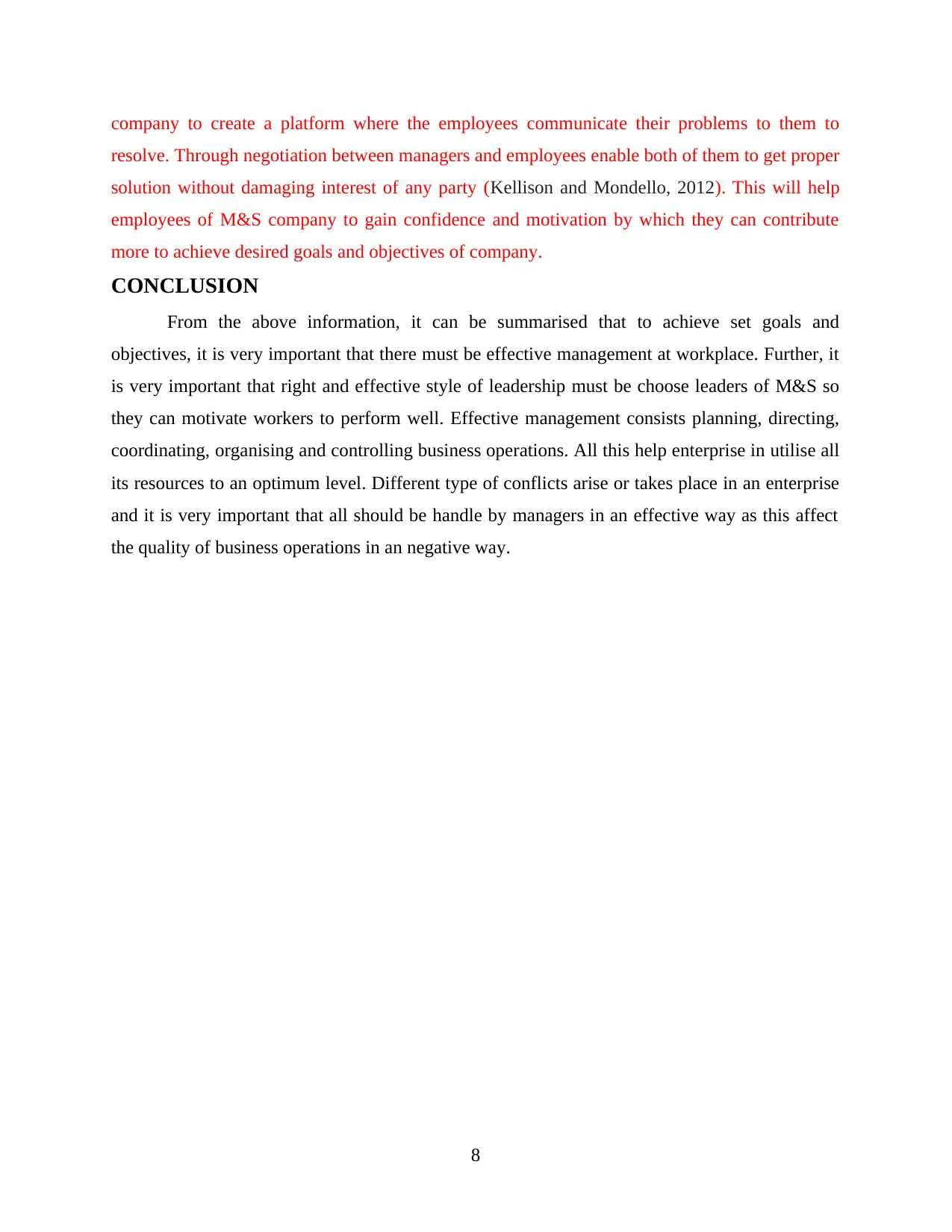
company to create a platform where the employees communicate their problems to them to
resolve. Through negotiation between managers and employees enable both of them to get proper
solution without damaging interest of any party (Kellison and Mondello, 2012). This will help
employees of M&S company to gain confidence and motivation by which they can contribute
more to achieve desired goals and objectives of company.
CONCLUSION
From the above information, it can be summarised that to achieve set goals and
objectives, it is very important that there must be effective management at workplace. Further, it
is very important that right and effective style of leadership must be choose leaders of M&S so
they can motivate workers to perform well. Effective management consists planning, directing,
coordinating, organising and controlling business operations. All this help enterprise in utilise all
its resources to an optimum level. Different type of conflicts arise or takes place in an enterprise
and it is very important that all should be handle by managers in an effective way as this affect
the quality of business operations in an negative way.
8
resolve. Through negotiation between managers and employees enable both of them to get proper
solution without damaging interest of any party (Kellison and Mondello, 2012). This will help
employees of M&S company to gain confidence and motivation by which they can contribute
more to achieve desired goals and objectives of company.
CONCLUSION
From the above information, it can be summarised that to achieve set goals and
objectives, it is very important that there must be effective management at workplace. Further, it
is very important that right and effective style of leadership must be choose leaders of M&S so
they can motivate workers to perform well. Effective management consists planning, directing,
coordinating, organising and controlling business operations. All this help enterprise in utilise all
its resources to an optimum level. Different type of conflicts arise or takes place in an enterprise
and it is very important that all should be handle by managers in an effective way as this affect
the quality of business operations in an negative way.
8
Paraphrase This Document
Need a fresh take? Get an instant paraphrase of this document with our AI Paraphraser
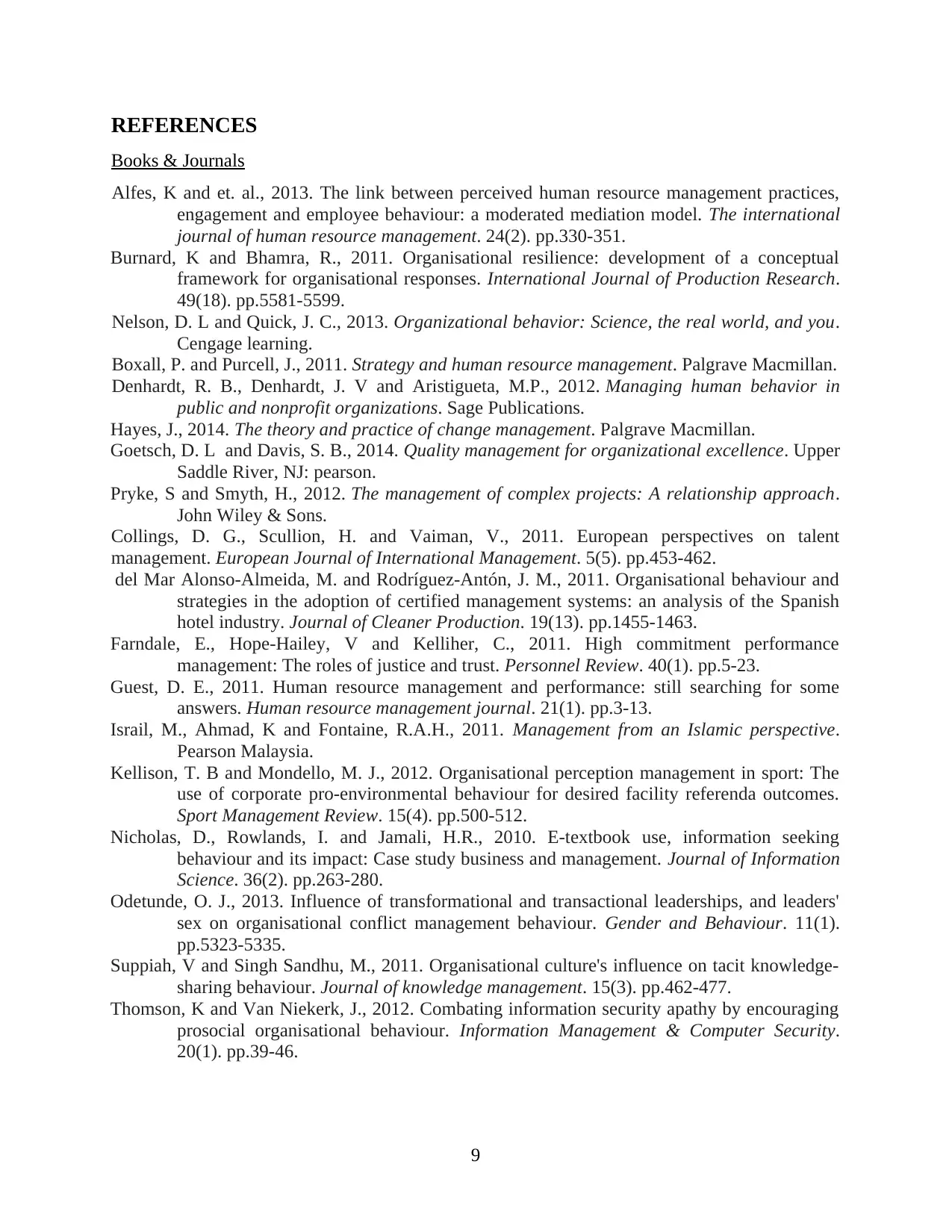
REFERENCES
Books & Journals
Alfes, K and et. al., 2013. The link between perceived human resource management practices,
engagement and employee behaviour: a moderated mediation model. The international
journal of human resource management. 24(2). pp.330-351.
Burnard, K and Bhamra, R., 2011. Organisational resilience: development of a conceptual
framework for organisational responses. International Journal of Production Research.
49(18). pp.5581-5599.
Nelson, D. L and Quick, J. C., 2013. Organizational behavior: Science, the real world, and you.
Cengage learning.
Boxall, P. and Purcell, J., 2011. Strategy and human resource management. Palgrave Macmillan.
Denhardt, R. B., Denhardt, J. V and Aristigueta, M.P., 2012. Managing human behavior in
public and nonprofit organizations. Sage Publications.
Hayes, J., 2014. The theory and practice of change management. Palgrave Macmillan.
Goetsch, D. L and Davis, S. B., 2014. Quality management for organizational excellence. Upper
Saddle River, NJ: pearson.
Pryke, S and Smyth, H., 2012. The management of complex projects: A relationship approach.
John Wiley & Sons.
Collings, D. G., Scullion, H. and Vaiman, V., 2011. European perspectives on talent
management. European Journal of International Management. 5(5). pp.453-462.
del Mar Alonso-Almeida, M. and Rodríguez-Antón, J. M., 2011. Organisational behaviour and
strategies in the adoption of certified management systems: an analysis of the Spanish
hotel industry. Journal of Cleaner Production. 19(13). pp.1455-1463.
Farndale, E., Hope-Hailey, V and Kelliher, C., 2011. High commitment performance
management: The roles of justice and trust. Personnel Review. 40(1). pp.5-23.
Guest, D. E., 2011. Human resource management and performance: still searching for some
answers. Human resource management journal. 21(1). pp.3-13.
Israil, M., Ahmad, K and Fontaine, R.A.H., 2011. Management from an Islamic perspective.
Pearson Malaysia.
Kellison, T. B and Mondello, M. J., 2012. Organisational perception management in sport: The
use of corporate pro-environmental behaviour for desired facility referenda outcomes.
Sport Management Review. 15(4). pp.500-512.
Nicholas, D., Rowlands, I. and Jamali, H.R., 2010. E-textbook use, information seeking
behaviour and its impact: Case study business and management. Journal of Information
Science. 36(2). pp.263-280.
Odetunde, O. J., 2013. Influence of transformational and transactional leaderships, and leaders'
sex on organisational conflict management behaviour. Gender and Behaviour. 11(1).
pp.5323-5335.
Suppiah, V and Singh Sandhu, M., 2011. Organisational culture's influence on tacit knowledge-
sharing behaviour. Journal of knowledge management. 15(3). pp.462-477.
Thomson, K and Van Niekerk, J., 2012. Combating information security apathy by encouraging
prosocial organisational behaviour. Information Management & Computer Security.
20(1). pp.39-46.
9
Books & Journals
Alfes, K and et. al., 2013. The link between perceived human resource management practices,
engagement and employee behaviour: a moderated mediation model. The international
journal of human resource management. 24(2). pp.330-351.
Burnard, K and Bhamra, R., 2011. Organisational resilience: development of a conceptual
framework for organisational responses. International Journal of Production Research.
49(18). pp.5581-5599.
Nelson, D. L and Quick, J. C., 2013. Organizational behavior: Science, the real world, and you.
Cengage learning.
Boxall, P. and Purcell, J., 2011. Strategy and human resource management. Palgrave Macmillan.
Denhardt, R. B., Denhardt, J. V and Aristigueta, M.P., 2012. Managing human behavior in
public and nonprofit organizations. Sage Publications.
Hayes, J., 2014. The theory and practice of change management. Palgrave Macmillan.
Goetsch, D. L and Davis, S. B., 2014. Quality management for organizational excellence. Upper
Saddle River, NJ: pearson.
Pryke, S and Smyth, H., 2012. The management of complex projects: A relationship approach.
John Wiley & Sons.
Collings, D. G., Scullion, H. and Vaiman, V., 2011. European perspectives on talent
management. European Journal of International Management. 5(5). pp.453-462.
del Mar Alonso-Almeida, M. and Rodríguez-Antón, J. M., 2011. Organisational behaviour and
strategies in the adoption of certified management systems: an analysis of the Spanish
hotel industry. Journal of Cleaner Production. 19(13). pp.1455-1463.
Farndale, E., Hope-Hailey, V and Kelliher, C., 2011. High commitment performance
management: The roles of justice and trust. Personnel Review. 40(1). pp.5-23.
Guest, D. E., 2011. Human resource management and performance: still searching for some
answers. Human resource management journal. 21(1). pp.3-13.
Israil, M., Ahmad, K and Fontaine, R.A.H., 2011. Management from an Islamic perspective.
Pearson Malaysia.
Kellison, T. B and Mondello, M. J., 2012. Organisational perception management in sport: The
use of corporate pro-environmental behaviour for desired facility referenda outcomes.
Sport Management Review. 15(4). pp.500-512.
Nicholas, D., Rowlands, I. and Jamali, H.R., 2010. E-textbook use, information seeking
behaviour and its impact: Case study business and management. Journal of Information
Science. 36(2). pp.263-280.
Odetunde, O. J., 2013. Influence of transformational and transactional leaderships, and leaders'
sex on organisational conflict management behaviour. Gender and Behaviour. 11(1).
pp.5323-5335.
Suppiah, V and Singh Sandhu, M., 2011. Organisational culture's influence on tacit knowledge-
sharing behaviour. Journal of knowledge management. 15(3). pp.462-477.
Thomson, K and Van Niekerk, J., 2012. Combating information security apathy by encouraging
prosocial organisational behaviour. Information Management & Computer Security.
20(1). pp.39-46.
9
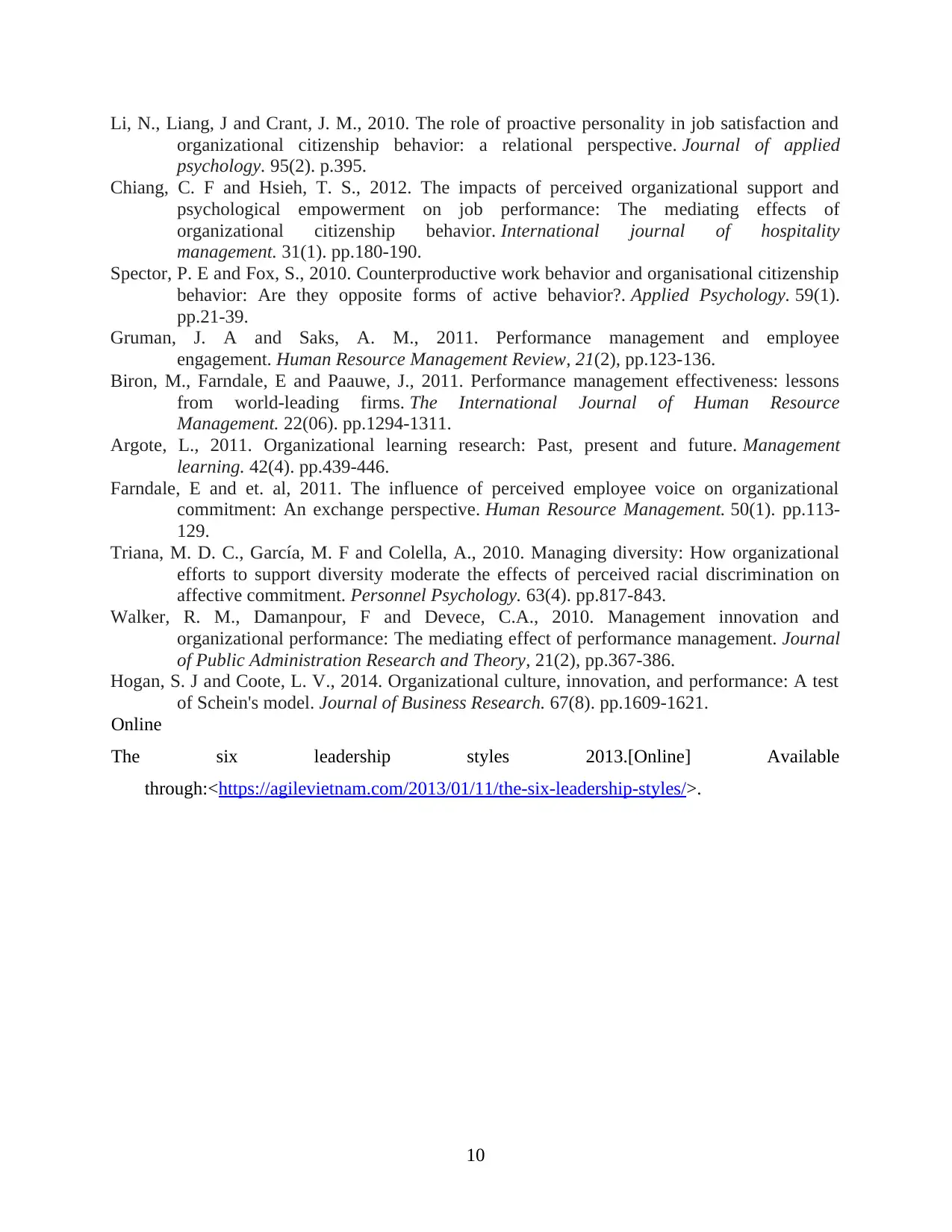
Li, N., Liang, J and Crant, J. M., 2010. The role of proactive personality in job satisfaction and
organizational citizenship behavior: a relational perspective. Journal of applied
psychology. 95(2). p.395.
Chiang, C. F and Hsieh, T. S., 2012. The impacts of perceived organizational support and
psychological empowerment on job performance: The mediating effects of
organizational citizenship behavior. International journal of hospitality
management. 31(1). pp.180-190.
Spector, P. E and Fox, S., 2010. Counterproductive work behavior and organisational citizenship
behavior: Are they opposite forms of active behavior?. Applied Psychology. 59(1).
pp.21-39.
Gruman, J. A and Saks, A. M., 2011. Performance management and employee
engagement. Human Resource Management Review, 21(2), pp.123-136.
Biron, M., Farndale, E and Paauwe, J., 2011. Performance management effectiveness: lessons
from world-leading firms. The International Journal of Human Resource
Management. 22(06). pp.1294-1311.
Argote, L., 2011. Organizational learning research: Past, present and future. Management
learning. 42(4). pp.439-446.
Farndale, E and et. al, 2011. The influence of perceived employee voice on organizational
commitment: An exchange perspective. Human Resource Management. 50(1). pp.113-
129.
Triana, M. D. C., García, M. F and Colella, A., 2010. Managing diversity: How organizational
efforts to support diversity moderate the effects of perceived racial discrimination on
affective commitment. Personnel Psychology. 63(4). pp.817-843.
Walker, R. M., Damanpour, F and Devece, C.A., 2010. Management innovation and
organizational performance: The mediating effect of performance management. Journal
of Public Administration Research and Theory, 21(2), pp.367-386.
Hogan, S. J and Coote, L. V., 2014. Organizational culture, innovation, and performance: A test
of Schein's model. Journal of Business Research. 67(8). pp.1609-1621.
Online
The six leadership styles 2013.[Online] Available
through:<https://agilevietnam.com/2013/01/11/the-six-leadership-styles/>.
10
organizational citizenship behavior: a relational perspective. Journal of applied
psychology. 95(2). p.395.
Chiang, C. F and Hsieh, T. S., 2012. The impacts of perceived organizational support and
psychological empowerment on job performance: The mediating effects of
organizational citizenship behavior. International journal of hospitality
management. 31(1). pp.180-190.
Spector, P. E and Fox, S., 2010. Counterproductive work behavior and organisational citizenship
behavior: Are they opposite forms of active behavior?. Applied Psychology. 59(1).
pp.21-39.
Gruman, J. A and Saks, A. M., 2011. Performance management and employee
engagement. Human Resource Management Review, 21(2), pp.123-136.
Biron, M., Farndale, E and Paauwe, J., 2011. Performance management effectiveness: lessons
from world-leading firms. The International Journal of Human Resource
Management. 22(06). pp.1294-1311.
Argote, L., 2011. Organizational learning research: Past, present and future. Management
learning. 42(4). pp.439-446.
Farndale, E and et. al, 2011. The influence of perceived employee voice on organizational
commitment: An exchange perspective. Human Resource Management. 50(1). pp.113-
129.
Triana, M. D. C., García, M. F and Colella, A., 2010. Managing diversity: How organizational
efforts to support diversity moderate the effects of perceived racial discrimination on
affective commitment. Personnel Psychology. 63(4). pp.817-843.
Walker, R. M., Damanpour, F and Devece, C.A., 2010. Management innovation and
organizational performance: The mediating effect of performance management. Journal
of Public Administration Research and Theory, 21(2), pp.367-386.
Hogan, S. J and Coote, L. V., 2014. Organizational culture, innovation, and performance: A test
of Schein's model. Journal of Business Research. 67(8). pp.1609-1621.
Online
The six leadership styles 2013.[Online] Available
through:<https://agilevietnam.com/2013/01/11/the-six-leadership-styles/>.
10
⊘ This is a preview!⊘
Do you want full access?
Subscribe today to unlock all pages.

Trusted by 1+ million students worldwide
1 out of 12
Related Documents
Your All-in-One AI-Powered Toolkit for Academic Success.
+13062052269
info@desklib.com
Available 24*7 on WhatsApp / Email
![[object Object]](/_next/static/media/star-bottom.7253800d.svg)
Unlock your academic potential
Copyright © 2020–2025 A2Z Services. All Rights Reserved. Developed and managed by ZUCOL.





